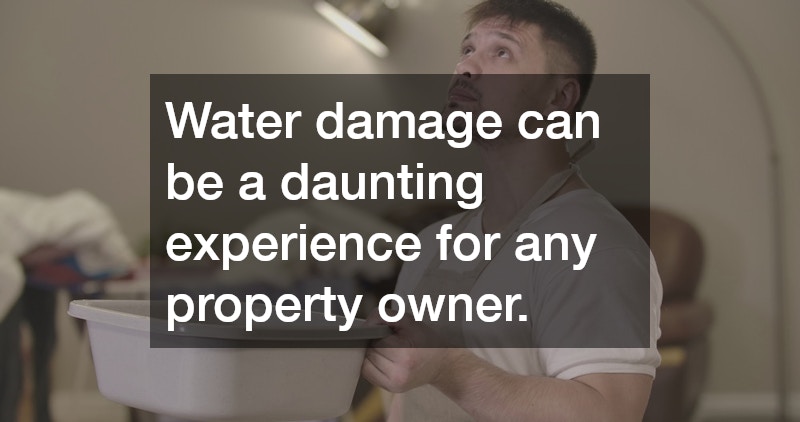What to Expect During the Water Damage Disaster Restoration Process
In this article, we will explore the critical steps and expectations involved in the water damage disaster restoration process. Water damage can be a daunting experience for any property owner, but understanding the process can make the restoration journey less overwhelming.
How Is Water Damage Assessed?
Initial Inspection and Damage Evaluation
The restoration process begins with a thorough inspection to identify both the extent and the source of the water damage. This step is crucial as it determines the subsequent actions needed for effective restoration.
During the inspection, professionals will use specialized tools like moisture detectors and hygrometers to assess the situation accurately. This allows them to quantify the moisture levels and pinpoint hidden leaks or affected areas.
They will also examine the impact on various building materials and any potential risks such as mold growth. By comprehensively understanding the damage, restoration teams can develop a focused and efficient plan tailored to the specific needs of the property.
Classification of Water Damage
Water damage is categorized into different classes and categories to determine the appropriate restoration approach. This classification helps in understanding the severity and the potential health risks associated with the situation.
Classifications include Class 1, which indicates minimal water absorption, and Class 4, which involves specialty drying situations due to deep saturation. Additionally, the water damage is categorized by the source, from clean to highly contaminated, affecting the cleanup process.
This systematic approach ensures that restoration teams use the right techniques and equipment, minimizing the potential for further damage. Proper classification is a cornerstone of effective water damage management.
What Steps are Involved in Water Extraction and Drying?
Water Extraction Techniques
Removing standing water from affected areas is a priority in the restoration process. This is achieved through various water extraction techniques that utilize specialized pumps and vacuums.
Speed is crucial during this stage to mitigate the risk of further structural damage or mold growth. Professionals often employ high-powered submersible pumps and industrial wet/dry vacuums to efficiently displace large volumes of water.
Once the bulk of the water is removed, attention can shift to addressing moisture that has permeated into building materials and furnishings. This step paves the way for thorough drying and dehumidification efforts.
Advanced Drying and Dehumidification
Advanced drying techniques are critical to ensure all moisture is eradicated from the property. The use of air movers and dehumidifiers accelerates the drying process, preventing mold and other moisture-related complications.
Technological advancements have provided restoration professionals with cutting-edge tools to monitor and manage humidity levels accurately. These tools ensure that no moisture is left behind, which could compromise the property’s integrity.
The goal is to return the environment to its normal moisture levels, safeguarding against potential health risks associated with residual dampness. Thorough drying is instrumental in preserving the property’s value and safety.
How Is a Property Restored After Water Damage?
Cleaning and Sanitizing
Ensuring a safe and sanitary environment post-restoration is paramount. Cleaning and sanitizing involve removing contaminants and applying antimicrobial treatments to prevent microbial growth.
Special attention is given to affected furniture, upholstery, and personal belongings to salvage and restore them where possible. This not only helps in reducing replacement costs but also maintains emotional ties to personal possessions.
Professionals employ safe yet effective cleaning agents and sanitizers tailored to the nature of the water damage. This comprehensive cleaning process is crucial for restoring a property’s hygiene and habitability.
Structural Repairs and Restoration
Concluding the restoration process involves addressing any structural damage that has occurred. This can range from minor repairs to full-scale reconstruction efforts to restore the property to its pre-damage condition.
Restoration teams work meticulously to repair walls, floors, and other structural elements affected by water damage. This phase often involves collaboration with carpenters, electricians, and other specialists to ensure quality and compliance with building codes.
Ultimately, the aim is to make the space fully functional and aesthetically pleasing again, helping property owners regain their sense of normalcy. Proper structural repairs solidify the success of the restoration process.
Conclusion
Understanding the water damage disaster restoration process is crucial for property owners. With a comprehensive approach to assessment, extraction, drying, and repairs, the journey from disaster to recovery can be managed efficiently and effectively.
Knowledge of these processes provides peace of mind, knowing that there is a structured path to recovering from water-related incidents. It is the diligence in following established restoration procedures that ensures a property can be safely inhabited once more.

